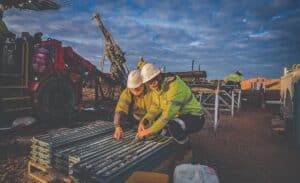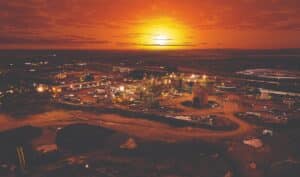Australian Mining spoke with Westgold Resources managing director and CEO Wayne Bramwell about how the company plans to continue its success in the new year.
If there is a company that embodies the success that the Australian gold mining sector has seen in 2024, it’s Westgold Resources.
From finalising a multi-billion-dollar merger with Karora Resources to delivering strong gold production across its operations, Westgold has had win after win.
Through Karora, Westgold has acquired the Beta Hunt and Higginsville gold mines in the southern Goldfields, allowing Westgold to expand its operational footprint beyond the Murchison region it has operated in for many years.
“We’re really excited and proud to put these two businesses together,” Westgold managing director and chief executive officer Wayne Bramwell told Australian Mining.
“Through the merger, we have picked up 500–600 employees, two more processing plants, one large underground mine, one small underground mine, and a massive exploration package within Higginsville.
“Karora operated in a very similar manner to us, so putting two businesses together that have a similar culture gives you a good basis to build from.”

Bramwell described the similarities and differences between the Murchison and southern Goldfields regions within a gold mining context.
“(When) talking about the southern Goldfields, and the Goldfields in particular, there are three main mineralising structures that control the bulk of the gold endowment,” Bramwell said.
“The Boulder Lefroy Fault, Zuleika Shear and Speedway Fault all run through the Higginsville package, so that was a real attraction to us. The Murchison probably has an endowment of 30 to 40 million ounces (Moz) of gold and the southern Goldfields is a little smaller than that.
“Both are very fertile and are historic gold producing regions. The southern Goldfields and Murchison are very underexplored and we are confident that drilling can add more reserve ounces to both.”
Westgold currently owns six underground mines: Big Bell, Bluebird, Starlight and Fender in the Murchison, Beta Hunt in the southern Goldfields, and Two Boys at Higginsville. The company operates all its mines except Two Boys, which is being operated by a small, specialist mining contractor.
“Being the complete owners, owning the fleet and having people to operate the fleet means we can move equipment and people around very quickly as new opportunities emerge,” Bramwell said.
“Mining is a dynamic environment. When using mining contractors, if you want to make a change to a plan, it will normally cost you more. A contractor will charge you a 20–30 per cent margin to use their capital which is understandable. Westgold owns that capital, so we don’t have to pay that additional margin.
“We’re a little unusual in that we do all our underground drilling. If we were doing that with a third party, it would cost us about 30 per cent more. Not having to pay that additional margin allows us to drill more metres underground, and we invest that additional expense back into the business.
“It gives us operational flexibility to do more with our own people and our own capital at a lower cost.”
Westgold produced 227,237oz of gold during the 2023–24 financial year (FY24), within the company’s FY24 production guidance of 220,000–230,000oz.
The company kept that momentum going in the first quarter of FY25, producing a record 77,369oz of gold from its newly expanded portfolio.

Additionally, Westgold ramped up its exploration activities across its operations, something the company will continue in FY25.
“We recommitted to drilling in 2022,” Bramwell said.
“Prior to that, the company didn’t drill enough to extend mine life or bring the next suite of assets on.
“We’ve drilled intensively at the Bluebird–South Junction project at Meekatharra. Within two years, it’s gone from a very small mine of 250,000 tonnes per annum to a run rate of 500,000 tonnes per annum.
“Through additional drilling, we’re stepping up the production rate to about 1.2 million tonnes per annum in the new year. The more you drill, the more you find. We’ve drilled that ore body intensively, and we’re not slowing down.”
Westgold hopes to unlock a third mining front at Bluebird–South Junction in order to lift its production run rate to above 1.5 million tonnes per annum.
The company is currently carrying out sub-level open stoping of the South Junction lode, with plans for Bluebird–South Junction to become the primary ore source for the nearby Bluebird processing plant, following the Triton–South Emu and Paddy’s Flat mines being paused.
“Within the Murchison, we have three processing plants: Fortnum near the Starlight mine, Tuckabianna which is largely fed by our Big Bell mine and our other Cue operations, and Bluebird at Meekatharra,” Bramwell said. “To keep the Bluebird mill fed, we’ve been trucking ore from our Cue operations.
“So how do we optimise the Murchison business? We make Bluebird–South Junction as big as we can so it’s matched with the Bluebird mill. That way, we don’t have to truck ore from Cue.
“(We’re) trying to replicate a simple model of having a mine and mill that are equally matched, which we’ve got with Starlight and Fortnum.”
The increased exploration in the Murchison led to Westgold delivering its first increase in ore reserves post depletion since FY17. As of June 30 2024, the company’s ore reserves sit at 50 million tonnes at 2.05 grams per tonne of gold for 3.3Moz of gold.
“Westgold has been effectively producing gold for many years, but it wasn’t replacing what it had depleted,” Bramwell said. “Seven years of shrinking your reserve is not something you can turn around overnight, so the last two years of drilling has finally shown that we can grow the reserve. We are now confident it will continue to grow.”
Westgold has also been growing its newly acquired Beta Hunt mine, with plans to continue exploration during FY25.

So far, the company has uncovered sediment-hosted coarse gold mineralisation within the Western Flanks orebody and defined a new exploration target at the Fletcher zone.
“Karora’s predecessor found a very high-grade vein called Father’s Day in about 2019,” Bramwell said.
“It was always thought to only exist in one part of Beta Hunt, that being the A zone. However, this sediment vein isn’t a flash in the pan. It’s been found in the A zone (and) we’ve now found it in the Western Flank zone. We expect it also exists in the Fletcher zone.
“We’re starting to accelerate Fletcher because we see that as the third mining front we can expand Beta Hunt above current production levels.”
With targeted exploration scheduled across its operations and production at the Great Fingall mine expected to commence in the fourth quarter of FY25, Westgold is poised to continue its operational success in the new year, leveraging the strong gold price.
“Westgold is now a top five ASX-listed gold company,” Bramwell said.
“We’re also a top 10 TSX-listed (Toronto Stock Exchange) gold miner. Our focus is the Murchison and southern Goldfields regions, and that’s where our focus is going to remain.
“We’ve got a portfolio of assets which we are confident we can leverage more production out of at a lower cost, and that’s really going to be our focus for the next 12 months.”
This feature appeared in the December 2024 issue of Australian Mining.




